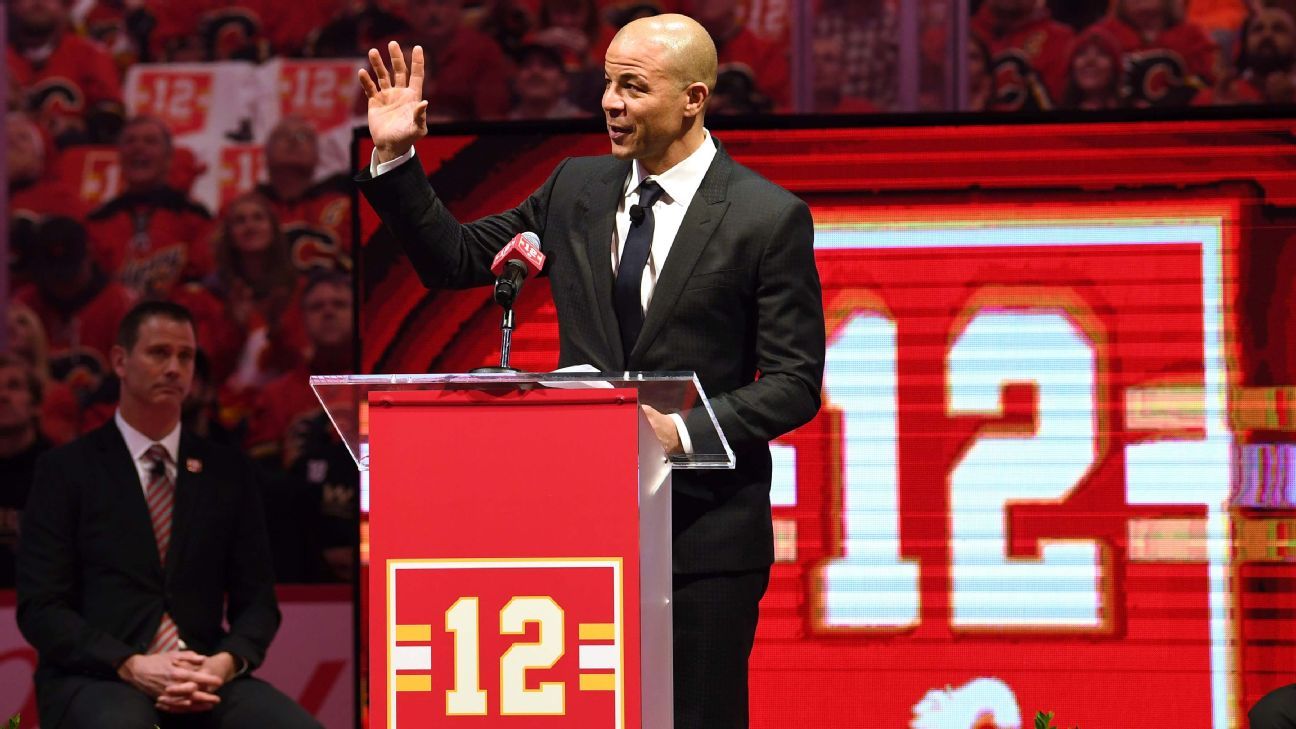The Hockey Hall of Fame Class of 2019 was as weird as was expected in a year without a slam-dunk candidate outside of Hayley Wickenheiser. Defenseman Sergei Zubov got in after a seven-year wait. Center Guy Carbonneau got in after 16 years. Czech hockey legend Vaclav Nedomansky was elected after a 33-year wait. What changed after 33 years? Who knows!
But enough about 2019. What will the Hockey Hall of Fame Class of 2020 look like? Here’s our current ranking of eligible candidates.
1. Jarome Iginla, left wing (first year)
A stone-cold lock for the first ballot. He has the numbers, with 625 goals (16th all time) and 1,300 points (34th). He has the accolades, with two goal-scoring titles and the 2002 Ted Lindsay Award. He was a winner … well, at least internationally, with gold medals at the Olympics (twice), worlds, world juniors and the 2004 World Cup of Hockey. One of the great ambassadors of the game, this is the kind of player for whom the Hall of Fame was built.
After missing out again, is Alfie officially being placed in the Hall of Very Good? The former Senators captain had 444 goals (No. 63 all time) and 1,157 points (No. 54 all time) during his 17-season run with Ottawa (and that other season in Detroit). He won the Calder Trophy, although no other individual hardware, and won Olympic gold and silver for Sweden. Like Iginla, his case is bolstered by the person he was away from the rink. Is that enough?
3. Marian Hossa, right wing (first year)
When we last did our Hockey Hall of Fame test cases, Hossa had three of the four essential quadrants for induction. His 525 career goals and 1,134 career points are strong; those goals put him in the neighborhood with Frank Mahovlich and Dale Hawerchuk, even though Hossa spent several years playing in the trap era. His 89 points in 110 playoff games are impressive, as are his five trips to the Stanley Cup Final (winning thrice). But he was under the radar: Respected for his 200-foot game, but only finishing once in the top three for an award (the Calder). Does he meet the “fame” criteria?
Mogilny’s 473 goals rank him 53rd all time, tied with Hall of Famer Denis Savard. Granted, he scored 27 percent of them in two seasons, with 76 goals in 1992-93 and 55 goals in 1995-96. But he was actually a model of consistency beyond that, with a 1.04 points-per-game average (38th all time, in a career that included playing in the trap era) in 990 career games over 16 seasons. A Triple Gold Club member, and an important part of hockey history as the first Soviet defection to the NHL. Clearly, the Selection Committee has opened up to Russian and Eastern European players making the Hall. That has to help his chances, right?
There’s been a new appreciation for Brind’Amour and his unique career. The former Hurricanes, Flyers and Blues center as one of the best 200-foot forwards of his era. He had 1,184 points (50th) in 1,482 career games, including 452 goals (58th) and played through the trap era. He won the Selke Trophy in consecutive years from 2005 to 2007 in his mid-30s, and he had 18 points during the Hurricanes’ 2006 Stanley Cup run. Too bad physique isn’t a criteria for the Hall; “Rod the Bod” would be first-ballot.
Roenick’s case is about the “fame” in Hall of Fame. At the height of his powers in his era, he might have rivaled only Wayne Gretzky for crossover appeal and cult of personality. (And, of course, his digital avatar made Gretzky’s head bleed in the movie “Swingers.”) He has 513 career goals, but that’s not a ticket-puncher. His 0.892 points-per-game average puts him right with Hall of Famer Joe Nieuwendyk. The problem with Roenick is that he never won an individual award nor a single championship or gold medal in his pro career.
With Zubov in, what does that mean for Gonchar? He played 1,301 games and amassed 811 points, which is 17th all time for defensemen. He won the Stanley Cup with Pittsburgh in 2009. A great defenseman who finished in the top five for the Norris Trophy four times, but one of the greatest defensemen? That’s debatable.
8. Kevin Lowe, defenseman (19th year)
Despite an endorsement from Wayne Gretzky at the 2018 Hall of Fame induction, Lowe continues to linger outside. He was the backbone of six Stanley Cup championship teams, including five with the dynastic Oilers who have already produced six Hall of Famers. But maybe he’s to the Oilers what Dave Concepción was to the 1970s Cincinnati Reds; a vital cog, but not part of the parade of Hall of Famers.
CuJo has the stats case for the Hall of Fame: fifth in career wins (454), sixth in games played (943). What he lacks is the impact. Joseph never won a Vezina Trophy (despite being in the top four five times) nor a Stanley Cup. To date, Ed Giacomin is the only Hall of Fame goalie not to have won a Cup. Goalies rarely get into the Hall of Fame — Martin Brodeur last season was just the seventh since 1990 — which also isn’t working in his favor.
10 (tie). Theo Fleury, right wing (14th year) and Patrik Elias, left wing (second year)
There are some loud voices in the hockey community shouting for Theo Fleury to be in the Hall. With 1,088 points in 1,084 games — including 455 goals — there’s an offensive case to be made. Keep in mind that while he popped for 51 goals during the firewagon hockey era, he also potted 46 and 40 during the trap years. The case against Fleury is that while he was an enormously popular player, he was top five for the Hart twice, for the Selke once … and that’s it as far as individual accolades.
Elias is a curious case. He had 1,025 points in 1,240 games from 1995 to 2016 with the New Jersey Devils. That puts him 13th in points in the NHL during that span and 14th in points per game. Internationally, Elias had 33 points in 40 games. He won the Stanley Cup twice. The case for Elias, if there is one, is that he was consistent, he was underrated and his numbers would have looked even better had he not played in the Devils’ system.
The other first-year candidates
After Iginla and Hossa, the most prominent name among first-year eligible players is probably winger Shane Doan, the career Coyote (after a rookie year in Winnipeg) he amassed 972 points in 1,540 games, a durability that ranks him 16th all-time in games played. Among the other names eligible are defenseman Brian Campbell, a smooth skater with 504 points who helped the Chicago Blackhawks win the 2010 Stanley Cup; and center Mike Ribeiro, whose 793 points were overshadowed by off-ice issues.
In 2021, things get really fun: Daniel and Henrik Sedin are first-year eligible. We’ll say it again: Double-entry, both on the same plaque. Other interesting 2021 names include former Red Wings star Henrik Zetterberg and Rick Nash, with 437 career goals.

